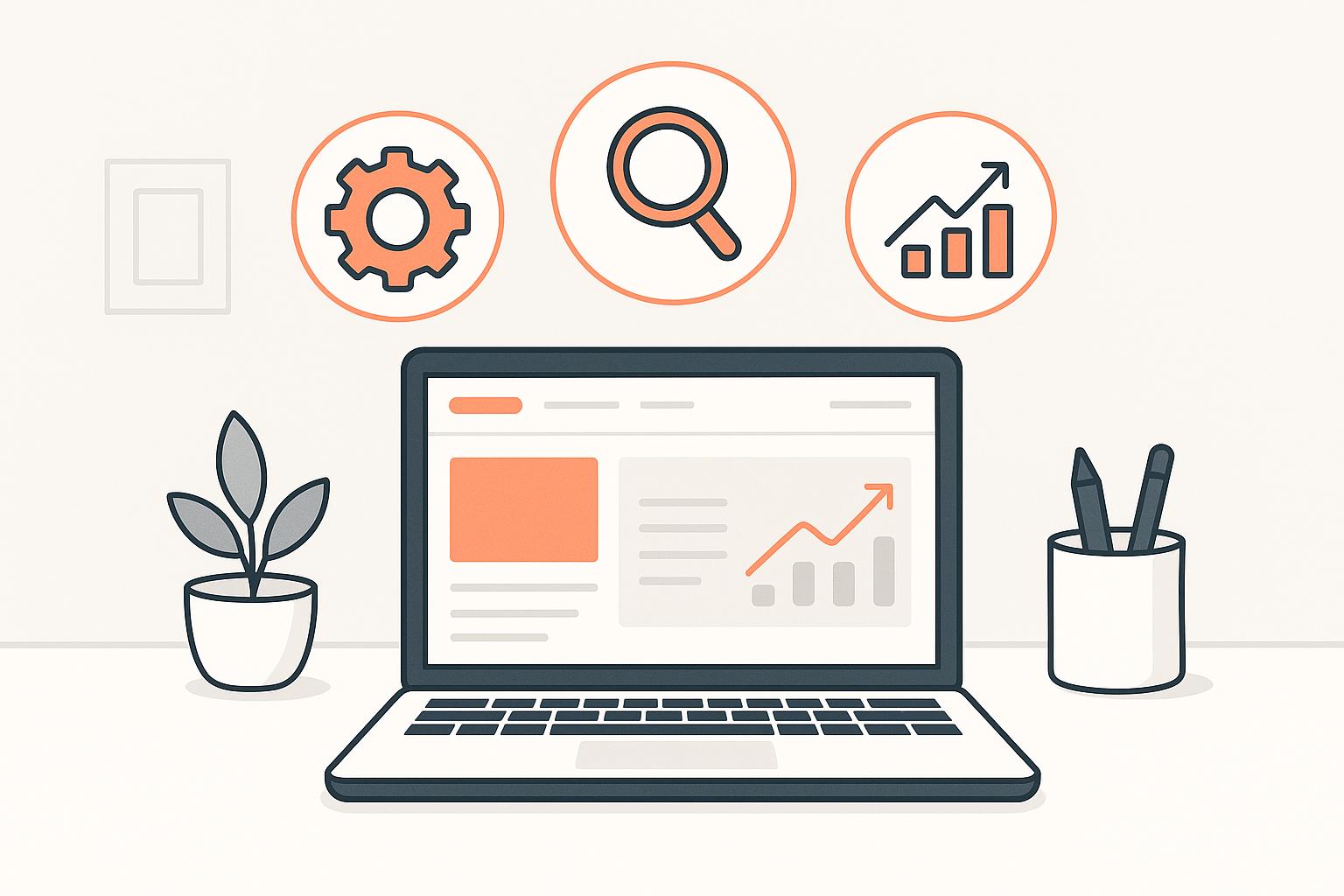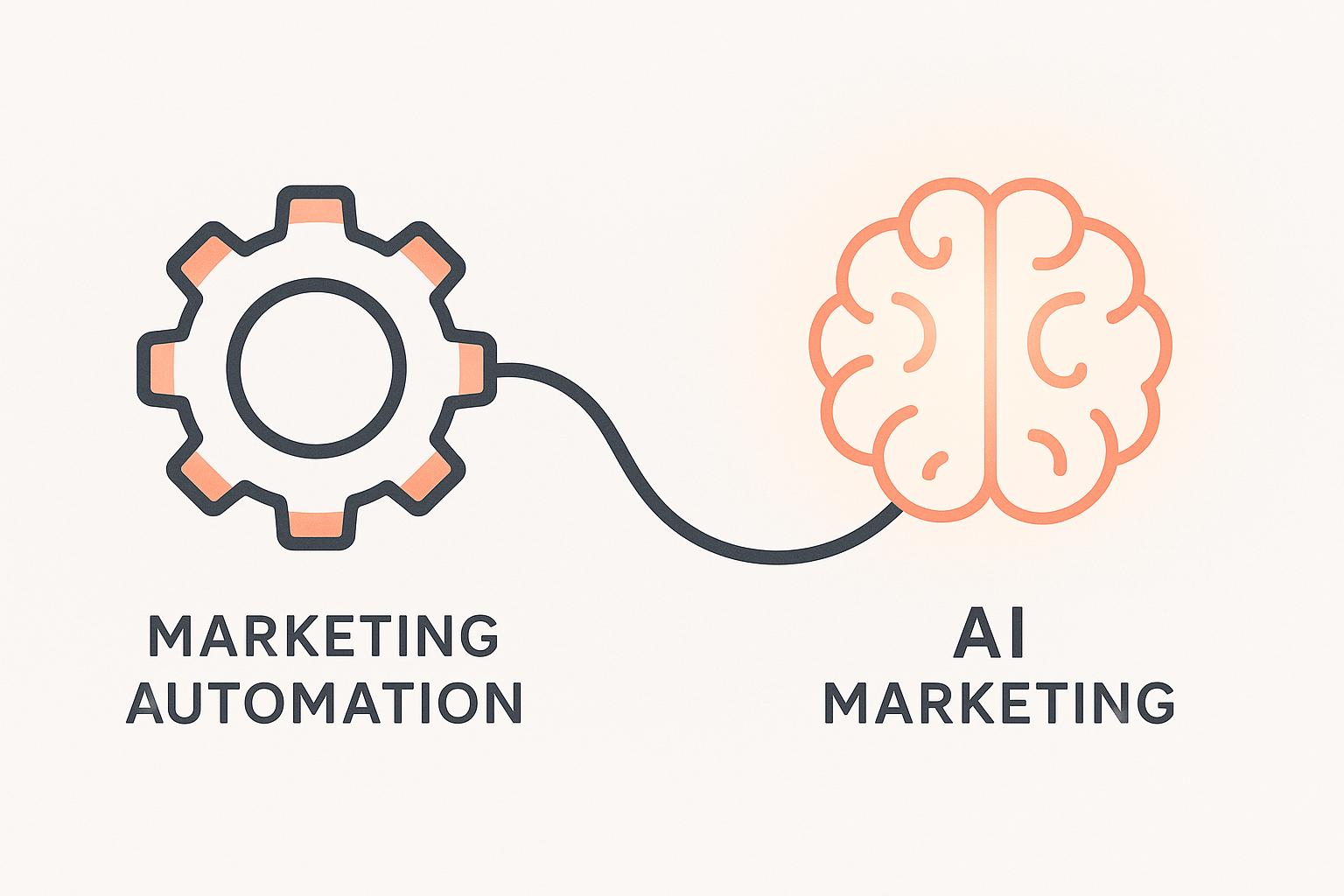Marketers often drown in data but still struggle to extract clear insights. With explainable AI analytics, turning raw numbers into actionable strategies is easier than ever. Here are 5 AI tools that simplify data analysis and provide clear, actionable insights for your marketing team:
- ThoughtSpot: Ask questions in plain English and get instant answers with natural language explanations and proactive anomaly detection.
- Power BI Copilot: Integrated into Microsoft’s ecosystem, it offers plain-language summaries, real-time anomaly detection, and marketing-specific insights.
- AnswerRocket: Combines natural language processing with intelligent alerts to simplify complex data and speed up decision-making.
- Google Analytics Generated Insights: Automatically detects trends and anomalies while providing clear, concise summaries for marketers.
- Qlik Insight Advisor: A conversational analytics tool that adapts to your organization’s unique language and delivers actionable insights.
Quick Comparison
| Feature | ThoughtSpot | Power BI Copilot | AnswerRocket | Google Analytics Generated Insights | Qlik Insight Advisor |
|---|---|---|---|---|---|
| Natural Language Explanations | Yes | Yes | Yes | Yes | Yes |
| Anomaly Detection | Yes | Yes | Yes | Yes | Yes |
| Marketing-Specific Insights | Yes | Yes | Yes | Yes | Yes |
| Ease of Use | High | Medium | High | High | Medium |
These tools empower marketers to make smarter, faster decisions by explaining data in simple terms. Whether you need instant insights, real-time alerts, or campaign-specific recommendations, there’s a tool for your needs. Read on to find the best fit for your team.
Using Generative AI to analyse and act on your marketing data
1. ThoughtSpot
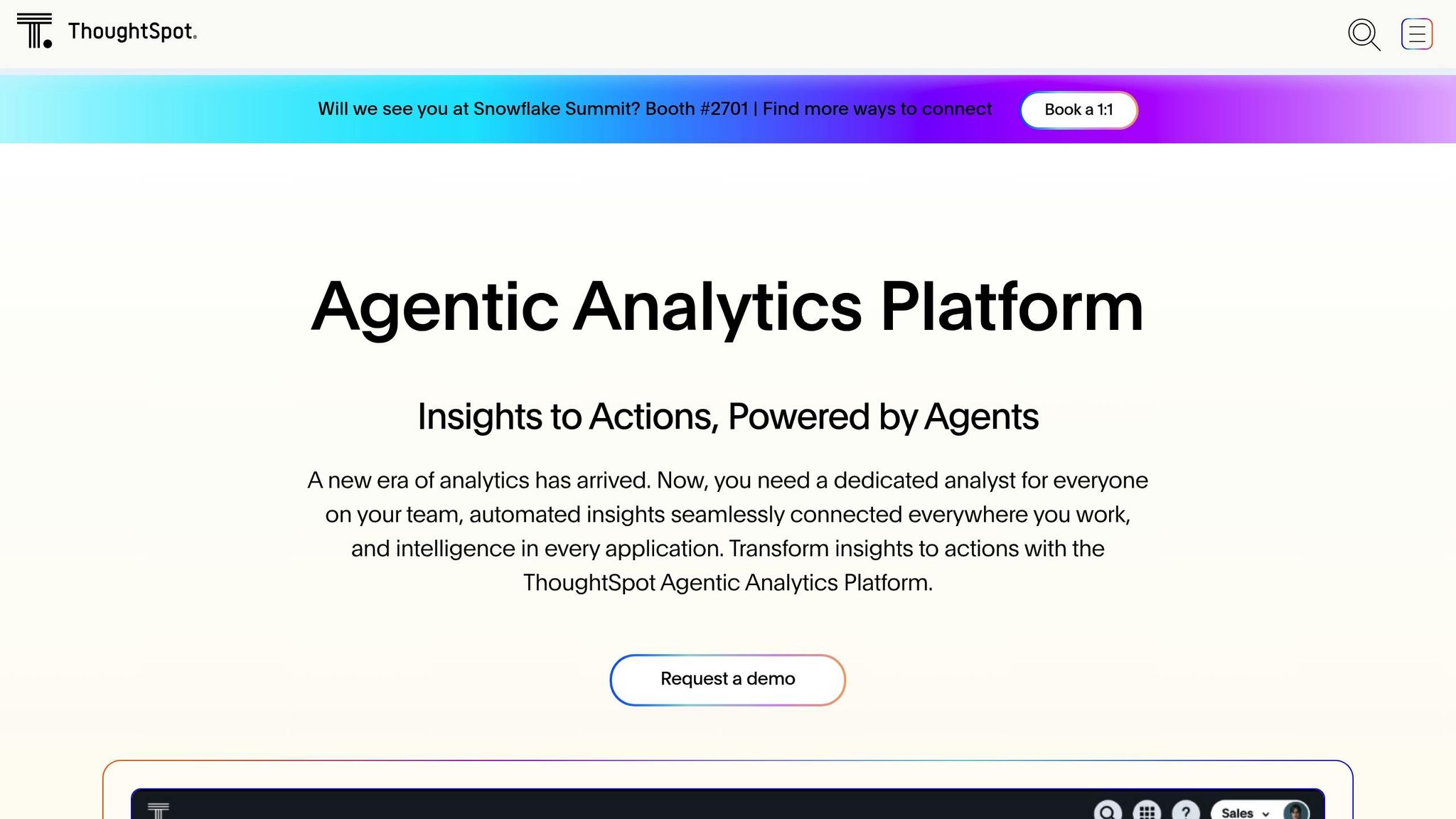
ThoughtSpot makes it easier for marketers to get the insights they need by allowing them to ask questions in plain English. Instead of wrestling with complicated dashboards or waiting for IT to step in, marketing teams can simply type questions like, "Why did our conversion rate drop last week?" and get instant, actionable answers.
Natural Language Explanations
With its Spotter AI Analyst, ThoughtSpot turns data into clear, conversational insights. Forget about complex SQL queries - this platform delivers results in straightforward language that anyone on the team can easily grasp.
"What really blew us away with ThoughtSpot was the approach to searching on the data with natural language, being able to be really approachable to the user." - Duessa Holscher, Principal Product Manager at Act-On
This simplicity addresses a common challenge for marketing teams. As Syed Ahmed, Act-On's SVP of Engineering, AI & Ops, explains:
"Our thought process was: how do we make it really easy for marketers to get insights? We had this idea of democratizing analytics... Marketers are technically savvy but they aren't data analysts, so having something really easy for them to access, and being able to understand their data, was very important for us."
Beyond its user-friendly language interface, ThoughtSpot takes things further by automatically identifying unusual patterns or shifts in data.
Proactive Anomaly Detection
ThoughtSpot's SpotIQ engine uncovers hidden trends, patterns, and anomalies without requiring users to dig through the data themselves. The Change Analysis feature doesn’t just flag anomalies - it explains what’s driving them.
Additionally, ThoughtSpot Monitor keeps teams informed by sending proactive alerts to mobile devices whenever key performance indicators change. This means marketers can respond immediately to unexpected events, like a sudden dip in web traffic or an unexpected spike in conversions.
For example, Northmill Bank used ThoughtSpot's anomaly detection to identify why some customers weren’t completing their sign-up process. By tweaking their onboarding strategy based on these insights, the bank saw a 30% increase in conversion rates. Tobias Ritzén, Former CFO at Northmill Bank AB, highlighted the value of these insights:
"It is all about being as relevant and personal as possible so users' personal finance can benefit from the insights. It can be getting a notification of a discount deal at your favorite cafe or a tailored offer to lower the cost of your insurance."
These automated tools make it easier for marketing teams to act quickly and make smarter decisions.
Marketing-Specific Insights
On top of its intuitive analytics, ThoughtSpot delivers insights tailored specifically for marketing. It helps teams optimize campaigns, better allocate budgets, and understand customer behavior - all without needing technical expertise.
Companies like Frontify and Austin Capital Bank have reported significant improvements in campaign performance and ROI thanks to faster insights and smarter spending decisions. ThoughtSpot's AI-driven tools also analyze which channels deliver the best results, helping marketers allocate budgets more effectively. By recommending personalized offers and content based on real-time customer behavior, ThoughtSpot enables brands to create experiences that resonate. In fact, 80% of consumers are more likely to make a purchase when brands provide personalized experiences.
This combination of simplicity, automation, and actionable insights makes ThoughtSpot a powerful ally for marketing teams looking to stay ahead.
2. Power BI Copilot
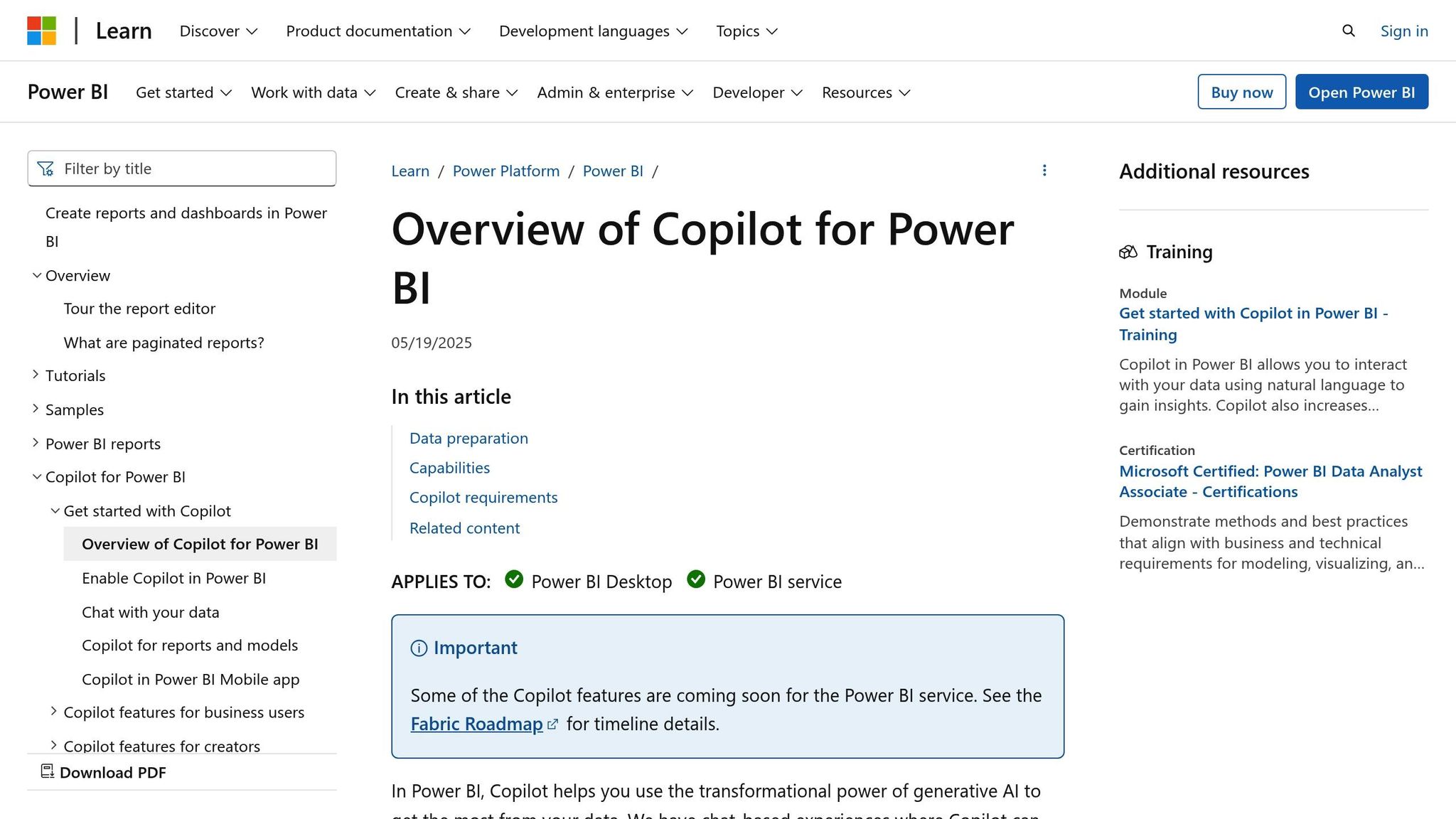
Power BI Copilot brings the power of AI-driven analytics directly into the familiar Power BI environment, making it easier for marketers to interact with their data without needing to learn a new tool.
Natural Language Explanations
With Power BI Copilot, marketers can ask questions in plain, everyday language. For example, a marketing team might ask, "Which social media campaigns generated the most leads this quarter?" and instantly receive clear answers - no need to dive into complicated database structures.
"Microsoft Power BI Copilot streamlines the report creation process, making it possible to generate reports and gain insights using natural language descriptions."
Copilot scans visuals to create concise summaries, highlighting key insights, trends, and outliers. This feature addresses a common challenge, as 62% of data professionals report that manual data preparation often delays their ability to extract meaningful insights.
Beyond delivering insights, Copilot also keeps users informed by monitoring data changes in real time.
Proactive Anomaly Detection
Another standout feature of Power BI Copilot is its ability to monitor data for unusual patterns. It can detect anomalies in time series data, such as unexpected spikes in website traffic or sudden drops in conversion rates.
"Anomaly detection helps you enhance your line charts by automatically detecting anomalies in your time series data. It also provides explanations for the anomalies to help with root cause analysis." - Microsoft Learn
When an anomaly is detected, Copilot doesn’t stop at flagging it. It analyzes various factors in the data model and offers natural language explanations along with possible causes. Teams can even adjust the sensitivity of the detection system to ensure they receive alerts that are both relevant and actionable. This proactive approach allows marketers to respond swiftly and make data-driven adjustments.
Marketing-Specific Insights
Power BI Copilot is designed with marketers in mind, delivering insights tailored to their unique needs. It helps teams refine their strategies by analyzing campaign performance, identifying high-performing channels, uncovering top customer segments, and spotting opportunities to optimize budgets.
"Copilot in Power BI enables marketing companies to analyze the performance of advertising campaigns in real time. This allows them to identify which channels are performing best, which customer segments are converting the most, and where marketing budgets are being used the least efficiently."
For e-commerce businesses, Copilot offers even more value by tracking advertising performance across platforms and creating comparative reports. These reports highlight areas where budgets can be better utilized. By analyzing conversion trends and customer behavior, Copilot equips marketers with actionable insights to fine-tune their targeting strategies and allocate resources more effectively. This personalized approach helps transform raw data into strategic decisions that drive results.
3. AnswerRocket

AnswerRocket combines natural language processing (NLP) and machine learning to turn complex data into straightforward, actionable insights. Its goal? To make advanced analytics accessible to everyone, regardless of their technical expertise.
Natural Language Explanations
What sets AnswerRocket apart is its conversational approach to data analysis. By leveraging NLP to interpret user questions and natural language generation (NLG) to deliver easy-to-understand answers, the platform simplifies data exploration. For example, marketers can ask, "Why did our conversion rates drop last month?" and receive clear, plain-English explanations.
"AnswerRocket positions itself as 'the AI-driven analyst for everyone.' It uses natural language processing (NLP), keyword searching, machine learning, and other technologies 'to ask business questions in natural language and get answers in seconds.'"
AnswerRocket's Max feature, powered by GPT-4, takes this simplicity a step further. CEO Alon Goren highlights the feature’s impact:
"Powered by GPT-4, Max makes it easy for everyone to understand and act on data, no matter their level of technical expertise."
This approach addresses a common challenge in the analytics world: low adoption rates for business intelligence (BI) tools. Studies show BI adoption rates can be as low as 25%, with self-service adoption stuck around 22-25% for years. By eliminating the need for complicated syntax or formatting, AnswerRocket helps more users engage with data effectively. Beyond simplifying communication, the platform also proactively monitors for irregularities.
Proactive Anomaly Detection
AnswerRocket doesn’t just respond to questions - it actively watches for anomalies and opportunities in your data. Using intelligent alerts, it flags unusual patterns before they escalate.
For example, a Fortune 500 cleaning products company used AnswerRocket to enhance their supply chain performance. The platform identified potential shipment risks and suggested corrective actions, leading to better inventory management and improved order fulfillment.
AnswerRocket’s anomaly detection relies on three key features:
- Smart Insights: Delivers automatic natural language insights.
- Conversational Search: Lets users ask questions in plain English.
- Intelligent Analysis: Quickly processes data to uncover insights in seconds.
Marketing-Specific Insights
For marketing teams, AnswerRocket provides tailored insights that speed up decision-making. By integrating with various data sources, the platform offers data science-backed insights that reduce analysis time from days or weeks to just hours or minutes.
In August 2024, AnswerRocket partnered with Kantar to merge its GenAI analytics platform with Kantar’s market expertise. This collaboration has enabled brands to drastically cut down the time needed for data analysis. The productivity boost is clear: insights teams have reported a 40% increase in efficiency, freeing them from manual data analysis and empowering business users to access insights on their own.
Chris Potter from CPW’s Global Applied Analytics team shared his excitement about the platform:
"Max will take AnswerRocket to the next level! We need our teams to make informed, fact-based decisions. Max will enable users across all levels of CPW to quickly access data and insights through intuitive questions and responses."
AnswerRocket’s versatility is also evident in other industries. A National Property & Casualty Insurance Provider used the platform to analyze claims and policy data. Marketers utilized these insights to refine customer targeting, while underwriters used the same data to set accurate pricing. This example highlights how AnswerRocket can support multiple departments by extracting actionable insights from shared data sources.
sbb-itb-ad96eed
4. Google Analytics Generated Insights

Google Analytics Generated Insights takes the guesswork out of data analysis, turning raw numbers into actionable strategies. By leveraging AI-powered tools, it simplifies complex data patterns and provides clear explanations, saving marketers countless hours of manual work.
Natural Language Explanations
One standout feature is its ability to transform confusing data trends into straightforward, conversational summaries. Instead of spending time combing through charts to figure out why there's a sudden spike or drop, the AI steps in to do the heavy lifting. As Google puts it:
"Generated insights are now shown directly within detailed reports in Google Analytics to give you clear, concise summaries explaining fluctuations in your data in plain language."
For example, in April 2025, the AI engine in GA4 flagged a spike in "Purchase" events and broke down the reasons behind it in an easy-to-understand format. This kind of clarity allows businesses to act quickly and stay ahead of unexpected changes.
Proactive Anomaly Detection
Another powerful feature is its ability to proactively identify unusual patterns in your data. Using machine learning, GA4 detects sudden changes - like a jump in conversion rates tied to a shift in demographics. When these anomalies occur, users with Admin, Editor, or Analyst access receive email notifications. You can also set up custom insights to focus on the metrics most critical to your business. This real-time monitoring not only helps you respond faster but also pinpoints the key factors driving these changes, whether they signal a problem or an opportunity.
Marketing-Specific Insights
Beyond identifying anomalies, Google Analytics Generated Insights helps optimize marketing efforts by breaking down performance shifts into actionable recommendations. The AI highlights significant changes in marketing metrics and explains what’s driving them, making it easier to adjust budgets or strategies. This can have a huge impact on productivity. Sara Swaney, Director of Advancement at 412 Food Rescue, shared:
"Google Analytics allows us to look at our data across platforms - web and app - to understand the full journey of our users. We've been able to cut our reporting time by 50%."
The tool's effectiveness is evident in real-world success stories. In 2024, McDonald's Hong Kong boosted in-app orders by 550% using insights from Google Analytics 4, while Lider achieved an 18X increase in conversion rates by leveraging the platform’s data-driven recommendations. These examples highlight how a detailed understanding of performance across channels, demographics, and regions can lead to faster, smarter campaign adjustments.
To make the tool even better, users can rate the usefulness of these insights, allowing Google to refine its suggestions to better align with specific business goals.
5. Qlik Insight Advisor
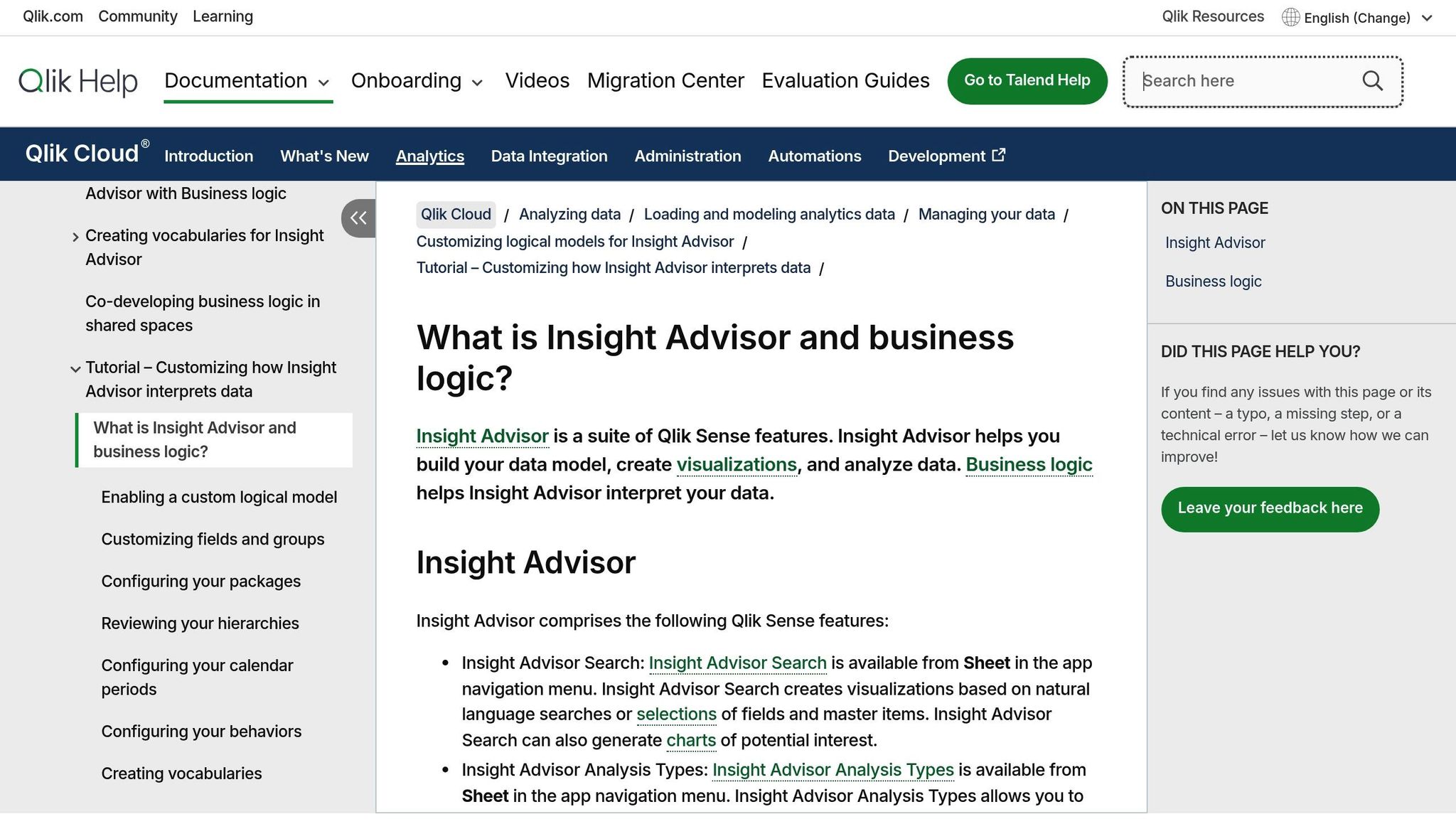
Qlik Insight Advisor combines conversational AI with analytics, making it easier to interact with complex data through straightforward questions and automated insights. Recognized by Gartner as a leader in AI-driven, natural language analytics since 2019, this tool has redefined how marketers engage with their data. While other tools also simplify data analysis, Qlik stands out with its ability to learn organizational language and integrate seamlessly with collaborative platforms. Let’s dive into its standout features, starting with its natural language capabilities.
Natural Language Explanations
Qlik Insight Advisor’s chat interface allows marketers to ask questions like, “What caused last month’s spike in conversions?” and receive both visual charts and narrative explanations. Over time, the platform adapts to your company’s unique vocabulary, including product names and industry-specific terms.
James Fisher, Qlik’s Chief Product Officer, shares the philosophy behind this feature:
"Analytics users want to do more with their data, but often struggle with where to look or what next steps to take. Insight Advisor gives these users a complete and powerful AI assistant, built directly into Qlik Sense, to help guide them along every step of their data exploration and analysis journey."
The tool supports multiple languages and integrates with platforms like Microsoft Teams and Slack, making insights readily available wherever teams collaborate.
Proactive Anomaly Detection
Qlik Insight Advisor doesn’t just respond to questions - it actively identifies patterns and trends in your data. It creates dashboards that flag unusual activity, helping teams spot issues or opportunities early. By blending machine intelligence with human intuition, it highlights outliers and uncovers hidden relationships within the data. This feature is particularly useful for catching shifts in campaign performance, customer behavior, or market trends as they happen.
As one IBM data scientist puts it:
"Predictive analytics is like having a crystal ball for your business. It allows you to see what's coming and prepare accordingly."
Marketing-Specific Insights
Qlik further tailors its capabilities to meet marketers' needs. It delivers targeted insights to optimize campaigns and improve customer engagement. For example, it can identify seasonal purchasing patterns or pinpoint customer segments with the most business potential.
The platform also enhances customer satisfaction with advanced sentiment analysis. PizzaExpress, for instance, has leveraged this feature. Dan Williams, their Business Intelligence Manager, shared:
"We're excited about the potential to leverage Qlik Insight Advisor to enhance customer satisfaction through deeper sentiment analysis, and Qlik AutoML for predictive trends that will help us engage our customers in new ways."
Mike Leone, Senior Analyst at Enterprise Strategy Group, also praises Qlik’s approach:
"I love Qlik's continued focus on natural language, including search and explainability. I believe it's the route to enabling wider adoption of analytics and visualization within organizations."
Additionally, Qlik’s Business Logic feature allows teams to set custom rules. This ensures that questions about metrics like conversion rates or customer acquisition costs return precise, consistent definitions.
Tool Comparison Chart
This chart provides a quick snapshot of how different AI analytics tools excel at turning raw data into actionable marketing insights. After diving into each tool's unique features, this summary simplifies the decision-making process by highlighting their core strengths.
| Feature | ThoughtSpot | Power BI Copilot | AnswerRocket | Google Analytics Generated Insights | Qlik Insight Advisor |
|---|---|---|---|---|---|
| Natural Language Explanations | Search-driven queries with instant visualizations | Conversational interface within the Microsoft ecosystem | Plain-English summaries in narrative form | Automated insights with clear trend explanations | Conversational interface offering actionable insights |
| Anomaly Detection | Real-time alerts for data outliers | Proactive notifications embedded in dashboards | Smart alerts paired with root cause analysis | Automatic detection of traffic and conversion anomalies | Proactive identification of patterns |
| Marketing-Specific Insights | Insights tailored for marketing KPIs and campaign analysis | Integrated with Microsoft advertising tools | Marketing-focused templates with industry benchmarks | Built-in e-commerce and conversion tracking | Tools designed to deliver insights for marketing strategies |
| Scenario Modeling | What-if analysis via search queries | Forecasting in an Excel-like interface | Predictive modeling for business impact scenarios | Projections targeting traffic and revenue | Advanced trend predictions using custom rules |
Key Differentiators by Use Case
- For instant insights: Google Analytics Generated Insights requires minimal setup and offers immediate alerts on trends like traffic spikes or conversion drops.
- Microsoft-centric organizations: Power BI Copilot integrates seamlessly with Microsoft's ecosystem, including Excel-based forecasting tools.
- For non-technical marketers: AnswerRocket simplifies attribution and customer journey analysis with plain-English insights and marketing templates.
- Data-heavy enterprises: ThoughtSpot's search-driven queries handle large datasets across multiple campaigns with ease.
- Collaborative teams: Qlik Insight Advisor delivers fast, actionable insights through an intuitive, conversational interface.
When choosing a tool, consider factors like implementation, training, and maintenance costs, especially in relation to your team size and data needs. For Microsoft users, Power BI Copilot might be the go-to choice, while those prioritizing simplicity may lean toward AnswerRocket. Use this framework to find the best fit for your marketing analytics goals.
Final Thoughts
Turning overwhelming data into actionable insights has reshaped the marketing landscape. These five AI analytics tools do more than just process numbers - they convert raw data into meaningful insights that influence real business decisions.
The stats tell the story: while 74% of companies claim they aim to be "data-driven", only 29% can effectively link their data to actionable steps. This disconnect highlights why explainable AI analytics tools have become a must-have for today’s marketing teams.
"AI analytics offer businesses transformative insights by analyzing vast amounts of data quickly and accurately. This technology enables companies to make data-driven decisions, predict trends, and optimize operations."
- Volkan Yolci, Business Developer at Demirören Yatırım Holding
The benefits extend well beyond simply understanding data. Explainable AI is driving over 10% annual growth for businesses. When it comes to client reporting, some agencies now spend as little as 15 to 30 minutes on reports, with 22% completing them in under 15 minutes.
The real value lies in turning data into actionable strategies. Instead of drowning users in endless spreadsheets, these tools provide timely and strategic insights. For instance, one ecommerce store identified high shipping costs as a major reason for cart abandonment. By introducing free shipping thresholds, they increased conversions by 20%. This is a perfect example of how explainable AI transforms raw data into business wins.
"As it evolves, analytics will shift from providing the numbers to providing advice and predictions to help you achieve your goals - your very own strategy assistant."
- Andrei Serbanoiu, Co-Founder at Socialinsider
Looking ahead, the future of marketing analytics is clear: it’s not about collecting more data but about delivering insights that directly support your goals. Whether you’re refining ad budgets, improving customer experiences, or proving ROI to stakeholders, AI-powered tools are the bridge between raw data and smart decisions, enabling marketers to act confidently and strategically.
FAQs
How can AI analytics tools help marketers make better decisions with their data?
AI analytics tools transform overwhelming data into straightforward, actionable insights, helping marketers make smarter decisions more quickly. With the power of predictive analytics, these tools can anticipate customer behavior, spot emerging trends, and reveal growth opportunities. For instance, they can pinpoint high-value customers, flag potential churn risks, and recommend the ideal timing for campaign launches.
What’s more, these tools make data analysis approachable - even for marketers without a technical background. By automating complex processes and presenting insights in an easy-to-digest format, AI analytics tools enable marketers to fine-tune campaigns, enhance audience engagement, and allocate resources wisely. The result? Improved efficiency and better overall business outcomes.
What key features should I consider when choosing an AI analytics tool for my marketing team?
When choosing an AI analytics tool for your marketing team, prioritize features that streamline data analysis and turn insights into actionable strategies. Start with a user-friendly interface - something intuitive enough for team members without a technical background to navigate easily. Another must-have is natural language processing (NLP), which lets your team ask questions in plain English and receive straightforward, useful answers.
Key features to consider include:
- Real-time analytics for the most current insights.
- Data visualization tools to make complex information easier to understand.
- Integration capabilities to ensure seamless connection with your existing marketing platforms.
Additionally, tools offering predictive analytics can help your team anticipate trends, while automated reporting simplifies the process of creating and sharing reports. Be sure to choose a solution that’s flexible enough to grow with your business as your needs evolve.
How do AI analytics tools detect anomalies, and why is this important for marketers?
AI analytics tools rely on machine learning algorithms to detect anomalies by analyzing patterns in data that stray from the usual trends. This capability enables marketers to quickly identify unexpected behaviors, like sudden performance drops, unexplained traffic spikes, or even signs of potential fraud.
The advantages of anomaly detection are clear. It allows for quicker decision-making thanks to real-time alerts, greater efficiency by tackling issues before they escalate, and stronger security by flagging irregularities that may hint at data breaches. Plus, these tools evolve alongside data trends, ensuring their insights stay accurate and meaningful as conditions change.
